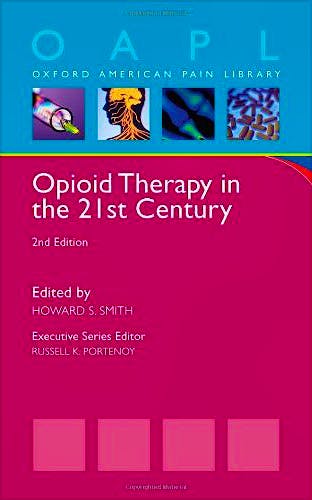

No hay productos en el carrito



Opioid Therapy in the 21st Century
Smith, H.
2ª Edición Mayo 2013
Inglés
Tapa blanda
240 pags
317 gr
13 x 20 x 2 cm
ISBN 9780199844975
Editorial OXFORD
LIBRO IMPRESO
-5%
47,49 €45,12 €IVA incluido
45,66 €43,38 €IVA no incluido
Recíbelo en un plazo de
2 - 3 semanas
About this book
- Concise, up-to-date, evidence-based information
Over the last thirty years, the concern of Pain Medicine practitioners about the potential for their patients to develop a dependence on opioids has left opioid therapy as a largely underutilized treatment. While there is no simple answer to chronic pain, opioids remain the only class of drugs capable of providing relief to patients experiencing serious pain. Opioid Therapy in the 21st Century, Second Edition fills a dearth of clinical knowledge about analgesics to aid practitioners in weighing the risks versus the benefits of opioid therapy for their chronic pain patients.
Part of the Oxford American Pain Library, this concise guide serves as a practical, user-friendly reference for physicians across the range of primary care and medical specialties. It includes an overview of appropriate clinical applications of opioids, covering such topics as opioid pharmacology, route selection, and individualization of therapy, as well as strategies for managing and mitigating the risk of abuse, addiction, and diversion. There are also special sections dedicated to the unique needs of pediatric, geriatric, and palliative care patient populations.
This second edition discusses opioids approved for use since publication of the first edition, such as Butrans (buprenorphine patch); fentanyl patch and nasal spray; abuse resistant version of Oxycontin; and Embeda (morphine sulfate). Approved indications for older opioids as well as clinical trial information have also been updated.
Readership: Hospice and palliative care physicians; primary care physicians
Table of contents
1 Introduction to Opioids
2 Overview of Opioid-Related Terminology
3 Diagnosis and Assessment of Pain
4 Opioid Pharmacology
5 Optimizing Pharmacologic Outcomes
5a. Drug Selection
5b. Route Selection
5c. Assessing and Managing Opioid Side Effects
5d. Opioid-Induced Hyperalgesia
5e. Principles of Opioid Rotation
5f. Individualization of Therapy
6 Opioid Therapy for Cancer Pain
7 Evidence for the Use of Long-Term Opioid
Therapy in Persistent Noncancer Pain
8 Pre-Opioid Prescribing Period
9 Identifying Patients at Risk for Pain
Medication Misuse
10 Potential Documentation Tools in Long-Term
Opioid Therapy
11 Managing the Risk of Abuse, Addiction, and Diversion
12 Special Populations
12a. Pediatric
12b. Geriatric
12c. Palliative care
13 Patients with a History of Substance Abuse
14 Resources
Appendix 1. Sample AAPM Consent for Chronic
Opioid Therapy
Appendix 2. Sample AAPM Agreement for Long-Term Controlled Substance Therapy
for Chronic Pain
Appendix 3. Numerical Opioid Side Effect
(NOSE) Assessment Tool
Appendix 4. Translational Analgesia Score (TAS)
Appendix 5. Clinical Guidelines for the Use of Chronic Opioid Therapy in Chronic
Noncancer
Pain: Opioid Treatment Guidelines
© 2025 Axón Librería S.L.
2.149.0